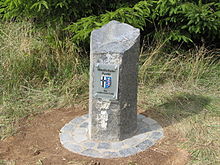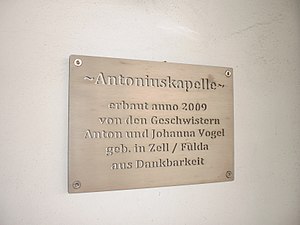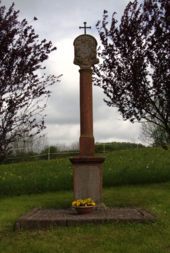Jossa (Hosenfeld)
|
Jossa
Municipality of Hosenfeld
Coordinates: 50 ° 29 ′ 26 ″ N , 9 ° 27 ′ 4 ″ E
|
|
|---|---|
| Height : | 424 (350–498) m above sea level NHN |
| Area : | 6.5 km² [LAGIS] |
| Residents : | 444 (Dec. 31, 2015) |
| Population density : | 68 inhabitants / km² |
| Incorporation : | December 31, 1971 |
| Postal code : | 36154 |
| Area code : | 06669 |
|
View of Jossa with the Catholic St. Rochus Church
|
|
Jossa is a district of the municipality of Hosenfeld in the eastern Hessian district of Fulda .
Geographical location
The village of the same name is located in the eastern Vogelsberg southwest of Hosenfeld an der Jossa , which flows into the Lüder to the north near Hainzell . Jossa, which was first mentioned in a document about 640 years ago, was originally settled by the Celts . The name Jossa is derived from the Celtic term "Jazza", which means something like bubbling or roaring ; this refers to the Jossa flowing through the village .
In the Jossa district, on September 9, 2008 on the western boundary of the Fulda district to the Vogelsberg district, at the Jossa / Gunzenau boundary, the basalt column was unveiled and the sign "Westernmost point of the Fulda district" was jointly carried out by the district councilors Bernd Woide ( District Fulda ) and Rudolf Marx ( Vogelsbergkreis ) as well as the mayors Bruno Block (Hosenfeld) and Friedel Kopp ( Freiensteinau ).
Forest areas near Jossa are the Gemänne and the Riedesel .
history
The village takes its name from the stream on which it lies. Its origin cannot be ascertained in the historical documents. Whether the prehistoric trade route Antsanvia contributed to the development cannot be proven. Its beginnings, however, certainly go back to the 10th century, like all places in the community of Hosenfeld. The name Jazza is mentioned for the first time in a document.
- 1375 The name Josse appears in the von Lüder property register.
- In 1477 a third of the village was enfeoffed by the Fulda abbots to the von Lütterz.
- In 1604 Jossa is also mentioned as a branch of the parish of Hosenfeld. At this point in time it was in the hands of the von Boyneburg and the von Romrode family of von Lüder. Together with Müs and Grossenlüder Castle (Fröschburg) it formed a court of the Buchischen knighthood.
- In 1703 the construction of the new Schlingenkapelle begins at the Schlingenhof.
- In 1811 Jossa had 56 fireplaces with 450 souls.
- In 1892/1893 the St. Rochus Church was rebuilt.
- On December 31, 1971, Jossa was incorporated into the municipality of Hosenfeld as part of the Hessian regional reform .
politics
Rüdiger Merz is the mayor after the local elections in Hesse in 2016 .
Sights and culture
Catholic Church
In the Jossa from Fulda builder is Ernst Kramer in the years 1892/1893 as a simple Sandsteinquarterbau with neo-Gothic forms as hall church built branch church of St. Roch. It belongs to the mother parish of St. Peter and Paul in Hosenfeld. The nave has four window axes with pilaster strips and a console frieze. In the interior of the church, a short, drawn-in choir with a three-sided end is added below the roof approach. In the interior there is a cross vault with painted ribs and belt arches on the wall pilasters. The chancel opens in a pointed arch on profiled warriors. Around 1900 the church received two colored glass windows in the choir which depict the Sacred Heart, St. Rochus and Wendelinus. The altar is a neo-Gothic carving. The pendant crucifix in the choir arch has an older body.
The Otto bell foundry from Hemelingen repeatedly cast bronze bells for St. Rochus in 1892 (the year of the consecration of the church), 1925 (between the wars) and 1950. Only one of the pre-war bells remained. So today there is a three-bell chime in the church tower from the Otto bell foundry in Bremen-Hemelingen with the chimes b, c sharp and dis. The oldest and smallest bell, the Josefsglocke , bears an inscription, the year 1925 and the old foundry mark of the Otto company. The sister bells fell victim to World War II and were not replaced until 1950. They have the new Otto logo. They are dedicated to St. Roch and Ave Maria .
Loop Chapel
The modest pilgrimage chapel of St. Maria (loop chapel ) also belongs to the subsidiary church of St. Rochus . It was built according to the plans of the Fulda Franciscan brother Antonius Peyer, instead of a previous building from the 17th century in 1703/1704. The last major renovation took place in 1993/1994. The loop chapel is still a magnet for pilgrims today . On the feast of the Assumption on August 15th is the highlight of the numerous pilgrimages.
Ebenhof - Antonius Chapel
Right on the edge of the forest near the Ebenhof, the siblings Anton and Maria Vogel, owners of the Ebenhof, built a chapel dedicated to St. Anthony and Our Lady . It has a small roof turret with a bell and a simple interior. After almost a year of construction, the new chapel was consecrated to St. Anthony on June 26, 2010 according to the Roman Catholic rite by the pastor of Hosenfeld, Father Robert Cmogorac, OFM and deacon Markus Hildebrand . The architect responsible was Volkmar Hubert from the neighboring houseleek .
The new community center
The center of Jossa was the focus of the Hessian village renewal program from 2000 to 2009 . Recognition took place in 2000. Numerous renovation measures in the private and municipal sectors were implemented during this time. Among other things, the abandoned and dilapidated former restaurant "Zur gute Quelle", which housed an inn and a grocery store as early as 1892, was renovated. The chronicle reports that the property was already run down in 1909. In 1913 the restaurant and grocery store were closed, but they continued to operate later. The stone-built basement of the former barn was used as a garage for the post bus route established after the Second World War . Jossa was the end point of the post bus route Fulda-Niederröderhöhe-Giesel-Hosenfeld-Jossa. The building wing was the center of village life for many decades after renovations by the Günther family, who built a new house with a restaurant and a hall instead of the former farm wing.
The stately half-timbered building from the 19th century then gradually lost its importance. In the 1960s, however, the new restaurant and grocery store in the old half-timbered building were closed forever. In the following years, the building complex was also used as a discotheque and refugee hostel for a short time and then stood completely empty for many years. The decay began and the onset of vandalism accelerated the process.
The historic half-timbered building was saved in good time through the village renewal. With a financial show of strength, the meanwhile owner, the community of Hosenfeld, has built a new community center with the help of the citizens . Due to the very large contribution of the population, the former village center became a center for the citizens again. In addition to the half-timbered house, which now shines in its old splendor, there is a large hall with a stage and side rooms in a typical village extension. In the basement there is a flower shop, a youth room, library and the office of the mayor. The whole area is now used as a community center . The inauguration and handover took place on July 9, 2005 by the then State Secretary Karl-Winfried Seif and von Hosenfeld, Father Robert Cmogorac, OFM under Mayor Bruno Block .
Wedding house Jossa
The stately half-timbered building (left) next to the hall wing of the community center (right) has housed the so-called "Wedding House Jossa" as a branch of the Hosenfeld registry office since May 2011 . The interior construction of the half-timbered house, which has not yet been completed since the construction of the community center, began in 2010 under the leadership of the architect Volkmar Hubert, Neuhof- Hauswurz . The interior work on the ground floor was carried out taking into account monument preservation aspects and was completed in May 2011. There, civil marriages take place in the former guest room of the former restaurant Zur Gute Quelle . The rooms were kept in their original condition when the half-timbered building was rebuilt and give the rooms a historical ambience.
Wayside shrine
The wayside shrine from 1766 in Jossa is a cultural monument.
Airfield
Jossa can also be reached from the air through the small "Fulda-Jossa" airfield , which is located a little south of the village.
Please refer
Individual evidence
- ↑ Population statistics of the community of Hosenfeld , accessed in December 2016.
- ^ Federal Statistical Office (ed.): Historical municipality directory for the Federal Republic of Germany. Name, border and key number changes in municipalities, counties and administrative districts from May 27, 1970 to December 31, 1982 . W. Kohlhammer GmbH, Stuttgart and Mainz 1983, ISBN 3-17-003263-1 , p. 394 .
- ↑ Local councils of the community of Hosenfeld , accessed in February 2017.
- ^ Gerhard Reinhold: Otto bells. Family and company history of the Otto bell foundry dynasty . Self-published, Essen 2019, ISBN 978-3-00-063109-2 , p. 588, in particular pages 506, 526, 547 .
- ↑ Gerhard Reinhold: Church bells - Christian world cultural heritage, illustrated using the example of the bell founder Otto, Hemelingen / Bremen . Nijmegen / NL 2019, p. 556, in particular pp. 473, 488, 504 , urn : nbn: nl: ui: 22-2066 / 204770 (dissertation at Radboud Universiteit Nijmegen).
Web links
- Internet presence of the municipality of Hosenfeld
- Jossa, district of Fulda. Historical local dictionary for Hessen. (As of November 7, 2016). In: Landesgeschichtliches Informationssystem Hessen (LAGIS).
- Literature about Jossa in the Hessian Bibliography









